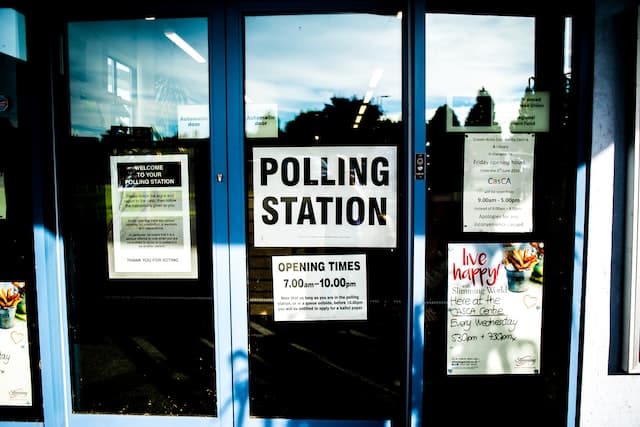The Republican Party has been boasting about its push to recruit thousands of poll watchers ahead of the 2022 midterms. While there have been no reports of equivalent claims on the Democratic side, experts say poll watchers in and of themselves are not cause for worry—they are, in fact, an essential part of the election process.
However, experts note that as some political groups and candidates continue to hammer the so-called “Big Lie”—that the 2020 Presidential election was “stolen” by Joe Biden—there are reasons to be concerned.
RNC Recruits Thousands of Poll Watchers
The Republican National Committee has been publicizing that it has recruited roughly 45,000 poll watchers and workers for battleground states ahead of the November elections. RNC Chair Ronna McDaniel said the effort is to “deliver transparency throughout the process.”
The DNC has not claimed equivalent numbers, but there have been random reports (by conservative media) of disproportionate hiring of Democratic poll watchers in scattered locations.
Suzanne Almeida, Redistricting and Representation Counsel for the non-partisan organization, Common Cause, tells Political IQ that while the RNC’s numbers might be slightly bigger than in years past, “This happens every single election. Our system is set up to have poll watchers for both parties inside the polls.”
And it’s not just parties that can have poll watchers. Individual candidates can, as well. “So the conversation around recruiting X number of poll watchers isn’t new,” she says.
Further, boasting doesn’t always translate to actual numbers on Election Day. “Even if we just go back to 2016 the numbers that the RNC said they were recruiting in battleground states, while significant—and again this is part of the process—didn’t end up being the overwhelming presence that I think everyone was worried about,” she says. “The same thing in 2018, the same thing in 2020.”
Reports of Disinformation, Misconduct Among Trainers
The bigger concern, Almeida says, is misbehavior by poll watchers. “If they’re harassing poll workers, if they’re slowing down the process with unnecessary challenges, if they’re racially profiling voters that they’re challenging based on the color of their skin or where they live or which party they’re voting for, that’s a different set of problems. And obviously, that is unacceptable.”
Rachel Homer, Counsel for the non-profit, non-partisan Protect Democracy, agrees. “Poll watchers themselves are not necessarily anything to be concerned about,” she stresses. “But certainly having ones that are told to break the rules, being told to interfere, being told to bring phones or recording devices and not follow the rules that are designed to make sure that they observe and don’t interfere, that’s something quite concerning.”
Homer adds that her organization has indeed seen a rise of that sort of misbehavior in the last few election cycles, cautioning that it “could lead to an increase in the risk of election subversion.”
There have been reports already this year that some of the groups training poll watchers are promoting election disinformation. These include a group led by attorney Cleta Mitchell who is still working to overturn the 2020 Presidential election.
And there have also been complaints of misconduct, including 15 counties in North Carolina, where officials say during the May primaries they observed poll watchers harassing voters and attempting to look at confidential voting records.
Following those complaints, the state elections board approved temporary rules for the November midterms, including a code of conduct that restricts poll watchers from standing too close to “tabulator, laptop, pollbook or other voting document” where they could view confidential information including marked ballots.
Who Polices the Poll Watchers?
Poll watchers are policed on a “state-by-state” basis, according to Almeida. “Poll watchers in most states have to have some sort of qualification within the state. They need a poll watcher certificate, they need to have been registered somewhere,” she says. “They’re associated with a candidate or party, so those are the folks who are responsible for training the poll watchers on the information.”
Meanwhile, Homer says the responsibility to counter the spread of disinformation falls on “a number of different folks,” including Republicans who are not election deniers. “There are plenty of them in state and local offices and leadership roles around the country,” she states, “and they really need to speak up and speak to their base to counter disinformation and explain that the 2020 election was not stolen.”
Several States Have Expanded Poll Watchers’ Powers
The Brennan Center has identified several states that have expanded the powers of poll watchers since the 2020 elections. In Georgia and Montana poll watchers can challenge any voters’ eligibility, while in Iowa, it is now a criminal offense for an election official to obstruct a poll watcher’s activities.
A new law in Texas gives poll watchers “free movement” around voting facilities so that they can “sit or stand near enough to hear or see the activity.” Anyone who knowingly obstructs a poll watcher’s view has committed a legal offense, and a Texas poll watcher can sue election officials who get in their way. Poll watchers may also observe the transfer of voting data.
However, Texas poll watchers are still prohibited from watching anyone cast their ballot, and must take the following pledge, “I swear (or affirm) that I will not disrupt the voting process or harass voters in the discharge of my duties.”
Both Almeida and Homer call the Texas law “concerning,” citing its vague language.
“What does it mean to get in the way of a poll watcher? If a poll worker is moving folks around to manage traffic flow in a polling place, is that standing in the way of a poll watcher?” asks Homer. “It’s opening poll workers to civil liability, or in some instances criminal liability, for just routine, minor mistakes or simple administration of a polling place.”
And, she adds, “It can really intimidate voters and ultimately prevent people from voting, and that’s extremely concerning.”
Poll: Americans Don’t Feel Safe at Polling Places
According to an August public opinion poll commissioned by the nonprofit Global Project Against Hate and Extremism, only 41% of Americans surveyed said they felt safe at polling places. That included just 28% of Black and 37% of Hispanic Americans saying they felt safe when they vote. (The survey did not include data on Asian Americans, Pacific Islanders or Indigenous people.)
But just a minority of white Americans surveyed—47%—said they felt safe when they voted, as well.
Feelings of security when voting increased incrementally with age, but in all age groups, a minority of those surveyed felt safe. 47% of Boomers said they felt safe voting compared to just 26% among members of Gen Z.
“Access is good, transparency is good, absolutely. But it has to be balanced with making sure that voters are safe at the polls and also feel safe at the polls, because of course it doesn’t work if people don’t participate,” says Almeida.


